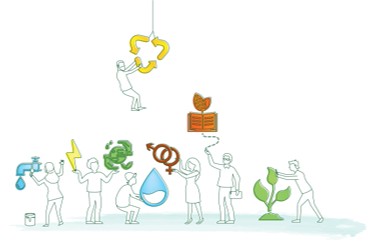Enterprise Profile
This type of enterprise focuses on offering products and services that are usually offered directly by the government, and provides them to end beneficiaries while being commissioned by governmental agencies. It predominantly operates in urban areas, where the need and willingness to pay for the government agency is highest, but can also serve rural areas.
Business Model Features
The enterprise offers products and/or services to end beneficiaries that should be offered directly by the government, usually in the area of treating or purifying water on a larger scale, servicing a public good. It is commissioned by government agencies that are unable to provide these products or services. While the enterprise can also target end-users (B2C) or businesses (B2B), its primary focus is on federal, state or local agencies, operating as a B2G business.
The enterprise is often publicly commissioned following a successful application and contracting process to an official request for proposal. Similar to B2B enterprises, B2G enterprises are attractive for investors due to higher and steady order volume. Yet, the contracting process usually is slow and tedious. As the needs of governmental agencies are very specific, it is crucial for the enterprise to understand the needs and requirements of its clients.
Context and Environment
Since the enterprises are usually publicly commissioned, their area of operation is predefined by the contracting government institution. As a consequence, the focus is usually on urban areas, where the majority of the population, and therefore, most end-beneficiaries live.
Target markets can include customers from both developed as well as developing countries, and depends more on the enterprises home and network than anything else. However, in order to ensure functional operation and collaboration with the government agency, the market needs to be in a relatively stable or conflict-free country.
Impact Potential
Due to the enterprise’s B2G business model, it typically has an indirect impact on end beneficiaries. The products and services of the enterprise are aimed at improving water treatment and distribution, or hygiene and sanitation solutions.
However, the potential to create impact for BoP communities and other marginalized groups depends largely on the government’s willingness to serve remote and low-income regions within the country. Thus, the impact is often indirect and it is challenging to prove the additionality and intentionality of the impact.
Potentially relevant SDG Targets
Water-related impact
SDG 6.1 By 2030, achieve universal and equitable access to safe and affordable drinking water for all.
SDG 6.2 By 2030, achieve access to adequate and equitable sanitation and hygiene for all and end open defecation, paying special attention to the needs of women and girls and those in vulnerable situations.
SDG 6.3 By 2030, improve water quality by reducing pollution, eliminating dumping and minimizing release of hazardous chemicals and materials, halving the proportion of untreated wastewater and substantially increasing recycling and safe reuse globally.
SDG 6.b Support and strengthen the participation of local communities in improving water and sanitation management.
Environmental impact
SDG 14.1 By 2025, prevent and significantly reduce marine pollution of all kinds, in particular from land-based activities, including marine debris and nutrient pollution.
Social impact
SDG 5.5 Ensure women’s full and effective participation and equal opportunities for leadership at all levels of decision-making in political, economic and public life.
SDG 8.5 By 2030, achieve full and productive employment and decent work for all women and men, including for young people and persons with disabilities, and equal pay for work of equal value.
SDG 8.6 By 2020, substantially reduce the proportion of youth not in employment, education or training.
SDG 8.8 Protect labour rights and promote safe and secure working environments for all workers, including migrant workers, in particular women migrants, and those in precarious employment.
Team and Experience
Given that the enterprise targets government agencies, which are not fond of taking risks, the team exhibits extensive knowledge across all relevant areas such as technology, production, financial management, and sales/marketing to assure their clientele. Not only are the products and services backed by in-depth technical and production expertise, but have been continually revised through R&D efforts. In case the enterprise targets beyond B2G, the team needs to have at least 4 years of marketing and sales experience, supplemented by extensive knowledge in financial management.
Financial Profile
This type of enterprises can be diverse in terms of financial requirements and performance. Depending on their solution, some enterprises require high capital expenditure, while others do not. Nevertheless, they all have a high profitability and are close to reaching break even or have already done so.
The fact that they have the government as client is their biggest indication for the enterprises’ financial viability, which attracts commercial equity and debt investors.
What are your Financing Options?
Given the technical and operational requirements of the government agency, these enterprises have been recipients of grants for R&D or operationalising their business model. In case of further financing needs for new product and service development, grant (especially government grant) should be of interest.
The fact that the enterprise creates mostly indirect impact and will face difficulty proving the additionality and intentionality of its impact, other result-based financing instruments are not suitable.
Equity, debt, or alike (common stock, preferred equity, convertible note, debt, venture debt, subordinated loan, revenue-based loan)
The enterprise’s ability to service the government proves to the investor that it has a reliable future cash flow, a proven and scalable business model, and a strong team that has the operational and technical expertise. Having other channels besides the government to achieve financial viability and impact will add to the likelihood of receiving financing.
In case the enterprise needs more operating cash flow before it enters the next fundraising round, venture debt will be a suiting option. Another instrument of interest could be revenue-based loan, which can benefit companies whose revenue is highly dependent on seasonal demand.


